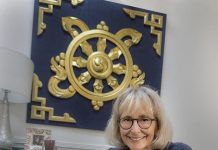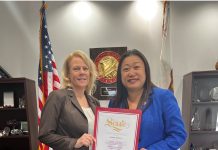
Florida printmaker and art dealer Gary Arseneau continues to earn his moniker “the Rodin chaser,” this time pursuing the record-setting Rodin exhibition at the Laguna College of Art and Design.
Arseneau is a self-appointed sleuth hunting for forgeries among French sculptor Auguste Rodin’s (1840-1917) huge trove of bronze sculptures, much of which has been exhibited throughout the United States and Canada. The North Carolina Museum of Art, the Los Angeles County Museum of Art and Calgary’s Glenbow Museum each have spurned Arseneau’s accusations of exhibiting fakes, earning him the sobriquet “Rodin chaser”.
Rodin is not his only quarry. Over the years, he’s cried “fake” at works by Degas, Renoir, Picasso and last year John Lennon when his drawings were exhibited at the Pacific Edge Gallery in Laguna Beach.
Thus, it’s hardly surprising that 14 Rodin sculptures exhibited beginning this month at LCAD have met his derision. In a mass e-mail issued this week to LCAD president Jonathan Burke and nearly the entire teaching staff, he denounced the trove on loan from the Iris and B. Gerald Cantor Foundation as non-disclosed posthumous (1925-1995) forgeries.
“What I saw (in the e-mail) was completely absurd. I have worked in a foundry and have been around bronze most of my life,” said LCAD instructor of sculpture, Raymond Persinger. His wife, sculpture instructor Marianne O’Barr, added that the works are beautiful and it’s an honor to see and touch them.
“The Dead Don’t Sculpt” remains Arseneau’s cri du coeur, one intended to override voices attesting that Rodin has made countless legitimate castings of works in his time in an effort to make a living and spread his legacy widely.
“Before Rodin died, he made arrangements with the French government to authorize post-humous casting of his work providing that it convert his Meudon (situated outside of Paris) studios and residence into a museum,” explained Judith Sobol, executive director of the Los Angeles-based Cantor Foundation.
She went on to say that the number of such casts were strictly regulated by laws passed in 1956 and again in 1981 to limit their number and stabilize their value. However, Rodin encouraged as many castings of his work during his life time but did not involve himself in the casting process otherwise. “Assistants took the figures to outside foundries with Rodin’s blessing. For his time, he was a great marketer,” she said. “During his lifetime, for example, 328 casts of ‘The Kiss’ were made.”
Then, sculptors modeled their creations mostly in clay and had foundries cast them in bronze by either using solid casts or the lost wax method.
Arseneau bases his criticisms largely on U.S. law, quoting the Seventh Edition of Black’s Law Dictionary’s definition of forgery as “the act of fraudulently making a false document or altering a real one to be used as if genuine.” He also refers to U.S. copyright law that defines a work of visual art, i.e. sculpture as multiple cast, carved, or fabricated (in editions) of 200 or fewer that are consecutively numbered by the author and bear the signature of other identifying mark of same.
Since the Rodins at LCAD are described as being numbered and signed “A. Rodin,” Arseneau opines: “The dead don’t sign, much less consecutively number.”
Sobol retorted that all labels in the exhibition are clear as to when the casts were made and by whom. “The is no attempt to hide any fraud because there is no fraud.”
LCAD president Jonathan Burke’s first response was: “I wrote Mr. Arseneau’s communication off as a prank at first; it does not seem as if he is very well informed.”
Today casts are still made to Rodin’s specification and under control of the French government, which allots limited numbers to museums and private collectors, said David Steel, European curator at the North Carolina Museum of Art, which has also exhibited Rodins courtesy of the Cantor Foundation. “Mr. Arseneau uses the word ‘fake’ to inflame the public. He has a point that post-humous casting does not directly benefit the artist and that distinctions should be made. But, if he uses words like ‘fake’ indiscriminately, he loses the moral advantage,” he said.
“If Rodin had not authorized all those casts, we might not even know what some of his most famous works would look like. All those multiples allow a broad range of the public to enjoy the works without having to travel to Paris.”
In an email, Burke said the exhibition already is setting gallery attendance records, thus achieving Rodin’s aim in permitting casting after his death. “He would be so pleased to know that audiences in the 21st century continue to be moved by his passion, sense of beauty and originality. I visit his art daily and feel renewed.”





The lede in this story includes “this time pursuing the record-setting Rodin exhibition at the Laguna College of Art and Design” — question (because it’s never explained in the story insofar as I can tell)… what about the exhibition is ‘record-setting’?
the president says the exhibit is isetting attendance records.